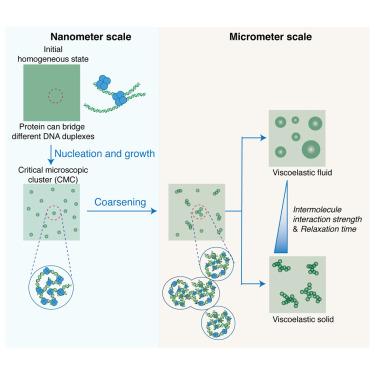Our official English website, www.x-mol.net, welcomes your
feedback! (Note: you will need to create a separate account there.)
Deciphering the molecular mechanism underlying morphology transition in two-component DNA-protein cophase separation
Structure ( IF 4.4 ) Pub Date : 2024-11-13 , DOI: 10.1016/j.str.2024.10.026 Cheng Li, Yunqiang Bian, Yiting Tang, Lingyu Meng, Peipei Yin, Ye Hong, Jun Cheng, Yuchen Li, Jie Lin, Chao Tang, Chunlai Chen, Wenfei Li, Zhi Qi
Structure ( IF 4.4 ) Pub Date : 2024-11-13 , DOI: 10.1016/j.str.2024.10.026 Cheng Li, Yunqiang Bian, Yiting Tang, Lingyu Meng, Peipei Yin, Ye Hong, Jun Cheng, Yuchen Li, Jie Lin, Chao Tang, Chunlai Chen, Wenfei Li, Zhi Qi

|
Nucleic acid and protein co-condensates exhibit diverse morphologies crucial for fundamental cellular processes. Despite many previous studies that advanced our understanding of this topic, several interesting biophysical questions regarding the underlying molecular mechanisms remain. We investigated DNA and human transcription factor p53 co-condensates—a scenario where neither dsDNA nor the protein demonstrates phase-separation behavior individually. Through a combination of experimental assays and theoretical approaches, we elucidated: (1) the phase diagram of DNA-protein co-condensates at a certain observation time, identifying a phase transition between viscoelastic fluid and viscoelastic solid states, and a morphology transition from droplet-like to “pearl chain”-like co-condensates; (2) the growth dynamics of co-condensates. Droplet-like and “pearl chain”-like co-condensates share a common initial critical microscopic cluster size at the nanometer scale during the early stage of phase separation. These findings provide important insights into the biophysical mechanisms underlying multi-component phase separation within cellular environments.
中文翻译:

破译双组分 DNA-蛋白质共相分离中形态转变的分子机制
核酸和蛋白质共缩合物表现出对基本细胞过程至关重要的多种形态。尽管之前的许多研究促进了我们对这个主题的理解,但关于潜在分子机制的几个有趣的生物物理问题仍然存在。我们研究了 DNA 和人类转录因子 p53 共缩合物——在这种情况下,dsDNA 和蛋白质都没有单独表现出相分离行为。通过实验分析和理论方法相结合的方法,阐明了:(1) 在一定观测时间内 DNA-蛋白质共缩合物的相图,确定了粘弹性流体和粘弹性固态之间的相变,以及从液滴状到“珍珠链”状共凝聚物的形态转变;(2) 共凝聚态油的生长动力学。在相分离的早期阶段,液滴状和“珍珠链”状共凝聚物在纳米尺度上具有共同的初始临界微观团簇尺寸。这些发现为细胞环境中多组分相分离的生物物理机制提供了重要见解。
更新日期:2024-11-13
中文翻译:

破译双组分 DNA-蛋白质共相分离中形态转变的分子机制
核酸和蛋白质共缩合物表现出对基本细胞过程至关重要的多种形态。尽管之前的许多研究促进了我们对这个主题的理解,但关于潜在分子机制的几个有趣的生物物理问题仍然存在。我们研究了 DNA 和人类转录因子 p53 共缩合物——在这种情况下,dsDNA 和蛋白质都没有单独表现出相分离行为。通过实验分析和理论方法相结合的方法,阐明了:(1) 在一定观测时间内 DNA-蛋白质共缩合物的相图,确定了粘弹性流体和粘弹性固态之间的相变,以及从液滴状到“珍珠链”状共凝聚物的形态转变;(2) 共凝聚态油的生长动力学。在相分离的早期阶段,液滴状和“珍珠链”状共凝聚物在纳米尺度上具有共同的初始临界微观团簇尺寸。这些发现为细胞环境中多组分相分离的生物物理机制提供了重要见解。


















































 京公网安备 11010802027423号
京公网安备 11010802027423号